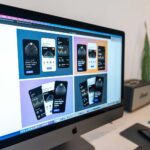
Connecting UX/UI Design and SEO
Today, simply having a visually appealing website is no longer sufficient to capture and retain user attention. To truly stand out, a website must prioritize user experience (UX) and user interface (UI) design, ensuring that it not only looks good but also functions seamlessly. However, one crucial aspect that often gets overlooked is the connection between UX/UI design and search engine optimization (SEO). In this article, we will delve into the symbiotic relationship between these two elements of web development and explore how their harmonious integration can pave the way for online success.
Establishing the Basis of User Experience (UX)
Creating a positive and purposeful connection between the user and the website is the primary purpose of UX design. This process involves comprehending the user’s requirements, choices, and behavior to design an enjoyable and straightforward experience. A carefully devised UX will make it easier for visitors to maneuver the website, find the needed data, and complete their tasks without difficulty.
How User Interface (UI) Impacts Us
The user experience is concerned with the entire experience of the user, while UI design concentrates on the visual components of a website, like layout, colors, typography, and interactive elements. An eye-catching UI not only boosts the site’s aesthetics, but also strengthens its brand identity, making a strong impression on users.
Influence of SEO on Website Exposure
Optimizing website content to appear higher in SERPs is what is known as SEO. Its ultimate purpose is to attract organic traffic and make the site more visible to users. When evaluating sites, search engines look at criteria including content relevancy, architecture, loading time, and mobile-friendliness.
User Experience and Website Loading Time
A key factor in which UX/UI design and SEO intersect is page speed. Fast loading times are what users anticipate and, moreover, what search engines use to determine rankings. An efficient UI encourages optimization of images and content, leading to improved loading times as well as a better user experience.
Users’ Feelings of Contentment with Mobile Adaptability
The amount of people who access the internet via mobile devices is on the rise, making it essential for websites to be optimized for mobile. Not only does this make them more likely to show up in mobile search results, but it also increases user satisfaction. A consistent UX/UI design, across all possible platforms, makes sure that visitors have the same experience, no matter which device they are using.
Engaging Users and Prolonging Their Time on Site
By providing users with an interesting UI and a seamless UX, the amount of time they spend on the website is increased. This prolonged presence is seen as an indicator of quality content by search engines, boosting the SEO rankings of the website.
Lowering the Bounce Rates
The bounce rate measures the proportion of visitors who abandon a website after viewing just one page. A high bounce rate can negatively affect your SEO efforts. To reduce this, an easy-to-use UX/UI design can be employed to make a more welcoming atmosphere and encourage visitors to explore more than one page.
Information Architecture and its Effect on Content Visibility
A UX/UI design that is properly formatted helps people quickly and easily find the content on your website. Clean navigation and labels that make sense will enable search engines to index your pages more efficiently.
Sharing Content Socially and Constructing Links
UX/UI design that captures the attention of visitors can lead to more shares of your content on social networks, thus expanding your reach and gaining quality backlinks. These social signals and backlinks are essential components for SEO, helping your website to climb the rankings in search engine results.
Final Thoughts
It is clear that UX/UI design and SEO are intertwined within today’s digital world. Having a website that not only offers a great user experience accompanied by an eye-catching user interface will help with higher search engine rankings. Investing in both of these components of web development can generate an effective online presence. This will draw in users and also keep them returning, which will lead to success in the online sphere. Therefore, when you are planning a website redesign or launching a new digital project, remember that the ideal combination of UX/UI design can transform your SEO strategy.























